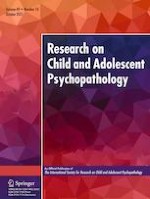29-04-2021 | Original Research
Distinguishing Transdiagnostic versus Disorder-Specific Pathways between Ruminative Brooding and Internalizing Psychopathology in Adolescents: A Latent Variable Modeling Approach
Gepubliceerd in: Research on Child and Adolescent Psychopathology | Uitgave 10/2021
Log in om toegang te krijgenAbstract
Rumination is correlated with diverse types of internalizing problems, but the extent to which it relates to a higher-order internalizing spectrum versus disorder-specific pathology is unclear. Using a quantitative model of the internalizing dimension, we compared the strength of transdiagnostic versus diagnosis-specific pathways from brooding—the most depressogenic component of rumination—to major depressive disorder (MDD) in adolescents. Community-recruited mid-adolescents (N = 241, Mage = 15.90 years, 53% female) completed semi-structured interviews of anxiety and depressive conditions and a self-report brooding measure. Confirmatory factor analysis revealed good fit for a one-factor model of internalizing conditions. Results revealed a large, significant factor correlation between brooding and the internalizing factor (r = 0.55), with some evidence for a more modest specific link between brooding and the unique component of the MDD diagnosis (r = 0.17; approximately one-third as large as the transdiagnostic pathway). These cross-sectional associations were generally consistent across two assessment waves separated by 19 months. We concluded that brooding is better conceptualized as a common characteristic of all internalizing problems in adolescence, rather than a specific feature of MDD. Preregistered hypotheses, data analysis code, and correlation matrices for this study are posted at https://osf.io/dax7u/.
